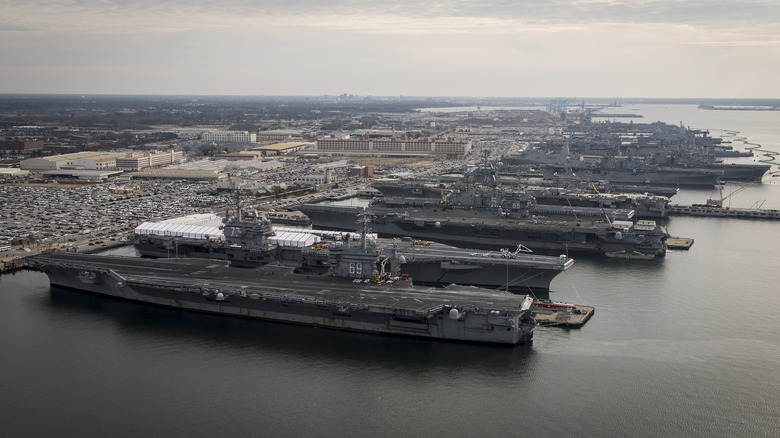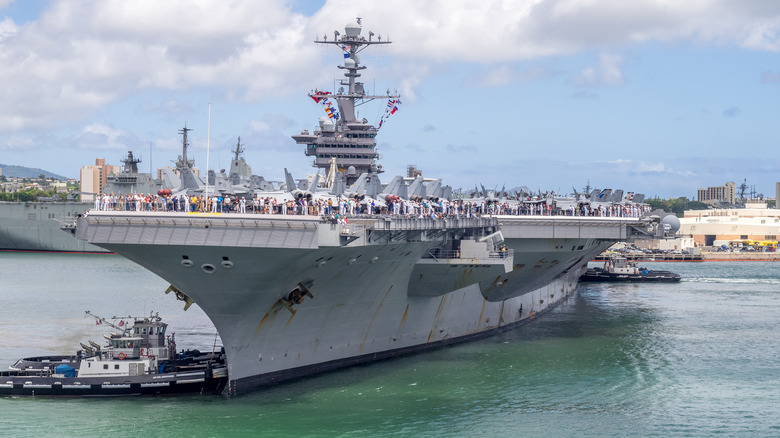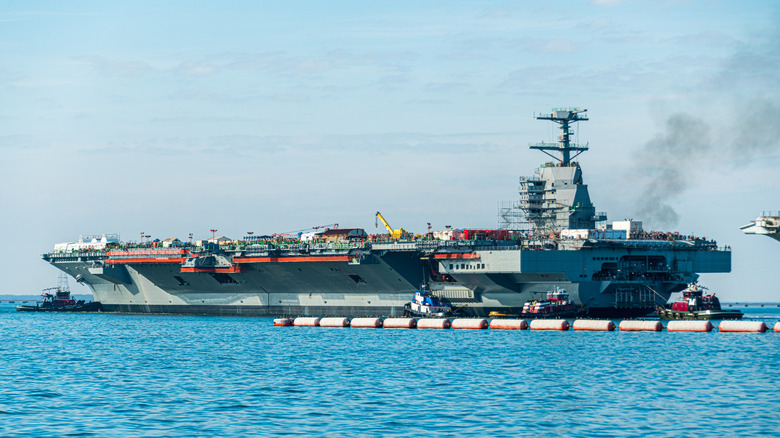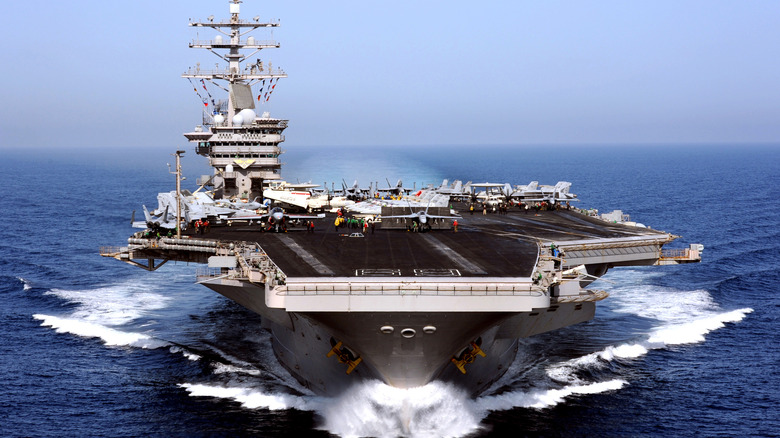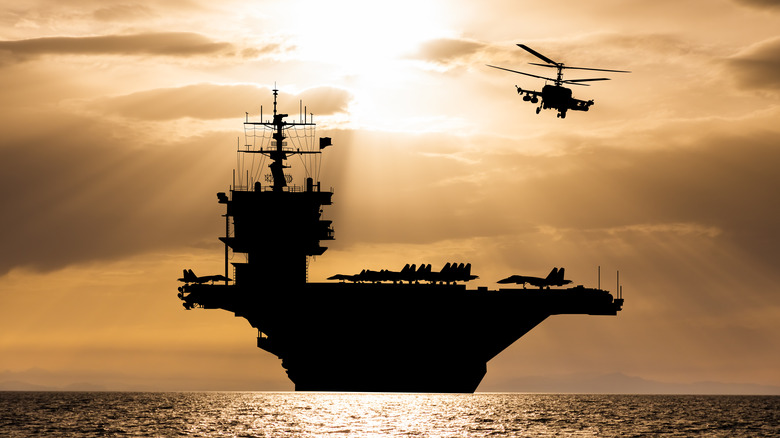The U.S. Navy's Aircraft Carrier Shortage Isn't What You'd Think
There's been a lot of racket across the internet about America suffering a shortage of aircraft carriers, but that information is a little ambiguous and confusing because America not only has some of the most advanced carriers in the world, it also has the most in service. Between the aging Nimitz-class and the modern Ford-class carriers, America has 11 operational aircraft carriers in service. "Operational" might be a bit of a misnomer because there are some carriers sitting in dry dock undergoing routine maintenance and refueling.
The issue is that there aren't enough carriers for everything the American government wants to accomplish. They're stretched thin due to multiple events taking place in hot spots around the world simultaneously on top of the regular maintenance they need. Irina Tsukerman, president and geopolitical analyst at Scarab Rising, told The National Interest, "The Navy has long been criticized for poor maintenance of its warships overall; the supercarriers due to their sheer size require extra care, which means that at any given point in time about a half of them is out of commission." Multiple carriers have seen extended deployments, which has caused them to return and undergo longer than usual repairs, leaving various areas of operation devoid of a carrier's presence.
There aren't many carriers in the Pacific
The United States has five of its carriers deployed to the east of the country and six deployed to the west. However, for the past few months there had been a major gap in America's presence in the Pacific as only one of the carriers was available if needed until very recently. The USS George Washington (CVN-73) only recently completed a crew and equipment swap before it deployed to Japan, making it the sole carrier in the Pacific for a period. Before that, the USS Nimitz (CVN-68), the oldest active carrier still in service, was undergoing maintenance over a six-month period of time.
While the USS Carl Vinson (CVN-70) was in the Pacific, it was indisposed due to its participation in the bi-annual Rim of the Pacific (RIMPAC) 2024 exercise. The USS Ronald Reagan (CVN-76) is currently undergoing a homeport change from Yokosuka, Japan, to Bremerton, Washington. Meanwhile, Secretary of Defense Lloyd Austin called for the USS Abraham Lincoln (CVN-72) to be deployed to the 5th Fleet – along with the USS Theodore Roosevelt last summer to assist in conflict in the Middle East.
Maintenance can be an issue
As with any mechanical asset, maintenance is required from time to time. It's even more pertinent with the largest ships at sea. The unfortunate truth about aircraft carriers is that the longer they're out at sea, the more maintenance they need to undergo. The Navy deployed the USS Gerald Ford (CVN-78) for its first combat deployment in May 2023. After eight months of deployment and three extensions, the 100,000-ton carrier was finally called back to its homeport of Norfolk, Virginia, in January 2024. Once the Ford returned to Virginia, it started undergoing a maintenance routine expected to last for a year at minimum, with it being unavailable for deployment until sometime in 2025 at the earliest.
Carriers typically deploy for seven months at a time because being out longer can put additional strain on them, leading to longer maintenance periods. It's even worse for older carriers. The USS Eisenhower (CVN-69) earned its commission in 1977 and had to sit in dry dock for 15 months, receiving maintenance when it returned from deployment in 2021.
Furthermore, extensions at sea can cause chaos to a routine maintenance schedule. Bryan McGrath, a former destroyer captain and head of the FerryBridge Group, a defense consulting firm, told Navy Times, "Without regular maintenance, the more things break, the more things get added to packages, those packages get bigger and the potential time that the ship spends in the yard potentially increases. The more you spend in the yard, the less time you have to get ready to get back out and get going next time."
The East Coast has its own problems
The United States East Coast hosts five carriers: USS Dwight D. Eisenhower, Truman, Bush, Ford, and Stennis, but they've been run a little ragged in recent years. Of those five, the Harry S. Truman (CVN-75) is the only one on deployment. It completed maintenance in December 2023, and once it finished some system exercises, it left Norfolk, Virginia, in September 2024, sailing for the 6th Fleet's area of operation in the Mediterranean. The Eisenhower returned from a nine-month deployment, which is again longer than the standard seven months, in July 2024 without an East Coast replacement at the time.
Instead, the West Coast carrier, USS Theodore Roosevelt, had to take its place, marking the first time a non-East Coast carrier operated in the Middle East. The USS Stennis (CVN-74), on the other hand, has seen repeated delays with repairs since 2021, and it's now not expected to be certified for deployment until 2026. In April 2023, the USS George H.W. Bush (CVN-77) returned to Virginia and didn't begin repairs until December, so it's unlikely to return to sea anytime soon.
The common denominator here isn't so much that there's a shortage of carriers; it's that they require an extensive amount of maintenance. Unfortunately, conducting fewer repairs and overhauls isn't the answer; otherwise, you end up with a USS Boxer (LHD-4) situation where it deployed for only 10 days because of issues with its rudder.
It's not a shortage, it's a combination of issues
As we said, calling it an aircraft carrier shortage is misleading. It's much more nuanced than that, as you can see. There are plenty of carriers at America's disposal, and even more are currently being built. It would be more apt to say that there's a shortage of resources and even manpower pertaining to the repairs, as that's the primary issue. A GAO report from 2022 noted a maintenance backlog totaling $1.8 billion. Without the resources, increasing America's inventory of carriers wouldn't do much to help. Even if it would, supply chain issues have delayed the construction of future Ford-class carriers.
Furthermore, multiple geopolitical hotspots stretch America's supply of aircraft carriers thin. From the war between Ukraine and Russia to the conflict in Israel and, more recently, conflicts with Houthi rebels. Sadly, this issue could end up having long-lasting ramifications.
Matt Shoemaker, former Defense Intelligence Agency (DIA) intelligence officer, told The National Interest, "However, should the conflict in the Middle East turn into a wider war, the Naval vulnerability in the Pacific would become a major issue the Chinese will almost certainly try to exploit through various means including sending their own ships into the Indo-Pacific area to crowd out other nations as well as messaging to countries friendly to Washington that America cannot protect them."
